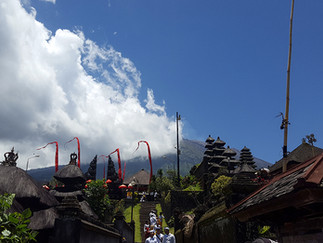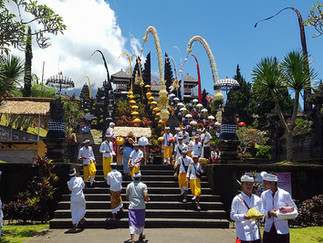Besakih Temple
- Shannon
- Sep 16
- 4 min read
The Mother Temple of Bali
The origins of Pura Besakih are veiled in ancient legend, its story whispered through centuries beyond recorded memory. For more than a thousand years, this sprawling temple complex has stood as the spiritual heart and the “Mother Temple” of the whole island. Perched nearly a kilometre above the sea, on the jagged southwestern flank of Mount Agung, it commands a breathtaking view and an air of sacred power. The temple was originally consecrated to Besakih, the legendary dragon deity still believed to dwell within the volcano’s fiery heart. Here, where earth and sky converge, the temple stands as a timeless gateway between the mortal world and the divine, a place where history, myth and faith intertwine in the shadows of Bali’s most sacred mountain.

The terraced layout of Besakih is both intentional and symbolic, resembling megalithic pyramids with tiered levels rising along the slope of the volcano. The complex includes 86 individual clan temples and 23 larger temple groups, all constructed on parallel stone ridges that climb in a linear sequence up the mountainside. This alignment along a single sacred axis reflects the Balinese Hindu concept of spiritual ascent, physically drawing devotees upward toward the peak and spiritually closer to the realm of the gods. Each temple serves a distinct purpose, representing different ancestral lineages, deities and rites, yet all are unified in their orientation toward the sacred summit. The entire structure functions as a mandala in three dimensions, guiding worshippers through increasingly sacred spaces as they move higher toward the heart of the mountain.

At the heart of Pura Besakih lies its spiritual nucleus, Pura Penataran Agung or the “Great Temple of State.” This towering sanctuary serves as the principal temple of the complex and is dedicated to Shiva, the powerful Hindu god of destruction and transformation. Pura Penataran Agung is part of a sacred triad of shrines representing the Hindu Trimurti, the divine trinity central to Balinese Hinduism. Alongside it stand Pura Kiduling Kreteg, devoted to Brahma the Creator and Pura Batu Madeg, honouring Vishnu the Preserver. These three temples are strategically aligned within the complex, each serving a distinct cosmic function while collectively representing the balance of creation, preservation and dissolution. Though Pura Besakih’s origins are much older, Pura Penataran Agung as it stands today is believed to date back to the 17th century, bearing centuries of religious ritual, royal patronage and volcanic resilience.

In 1963, Mount Agung awakened with terrifying fury. A series of cataclysmic eruptions tore through the land, unleashing pyroclastic flows and rivers of molten lava that obliterated entire villages and claimed the lives of at least 1700 people. Ash rained from the sky like a funeral shroud and the earth itself seemed to convulse in agony. Yet amid the devastation, Pura Besakih stood untouched, the lava veered away at the last moment, stopping just metres from the sacred complex. For many Balinese, this was no accident. It was a chilling omen, a display of divine wrath restrained. They believed the Gods had sent a brutal reminder of their power, willing to scorch the earth and take lives, yet sparing their temple as a solemn warning rather than a ruin. Pura Besakih only endured by divine decree.

Naga Besukian, the mythical dragon said to coil deep within Mount Agung, is no ordinary beast, it is the sacred guardian spirit of Pura Besakih and a force of nature in Balinese belief. Often associated with primordial forces connected to the earth’s underworld and fertility, naga like Besukian are believed to channel these potent energies from deep within the mountain, linking the sacred geography of the volcano to the spiritual structure of the temple. Locals say it was Naga Besukian who stirred during the catastrophic 1963 eruption, unleashing death and fire across the land, yet sparing the Mother Temple by mere metres. That act was not one of mercy but a deliberate warning. Even now, offerings are made to the dragon to maintain harmony and appease its volatile nature, because the boundary between guardian and destroyer remains tightly wound beneath the sacred mountain.
Pura Besakih is far more than a historic monument, it remains a living, breathing centre of Balinese spiritual life. Families from across the island journey here to mark important rites of passage, honour their ancestors and participate in grand temple festivals that pulse with color, music and devotion. Uniquely inclusive, it is one of the few temples in Bali open to all devotees, regardless of caste or lineage. Recognising its cultural and spiritual significance, Pura Besakih was nominated as a UNESCO World Heritage Site in 1995, testament to its enduring role as the sacred heart of the Island of the Gods.
🗺️ Location
Besakih Village, Jalan Raya Besakih, Rendang, Karangasem District, East Bali, Indonesia
🚆 How to get there
Besakih is located approximately 68km’s or 3 hours drive from from Kuta and 50km's or a 2 hour drive from Ubud and is easiest with a private car and driver. While adventurous travellers may opt to rent a scooter, it's a long and occasionally steep ride. Be aware that ride-sharing services like Gojek or Grab do not operate in the Besakih area, making return trips tricky if you arrive without your own transport.
⭐ Attraction Info
While the temple remains open for prayers 24 hours a day, tourists are only allowed between 7am - 6pm. The admission fee is a rather hefty 150,000 IDR for adults, which includes a mandatory local guide to help you navigate the sprawling complex. Your ticket also covers a traditional sarong rental, required as a sign of respect, with staff on hand to assist you in putting it on. Also included is a one way shuttle bus ride to the top near the main entrance. From there you can choose to walk back down (about 15 minutes) or pay an additional 20000rp per person for the return shuttle. Most visitors spend 2 to 3 hours exploring the temple grounds, with the best times to visit being early morning or just before sunset.
🔗Official Website



































